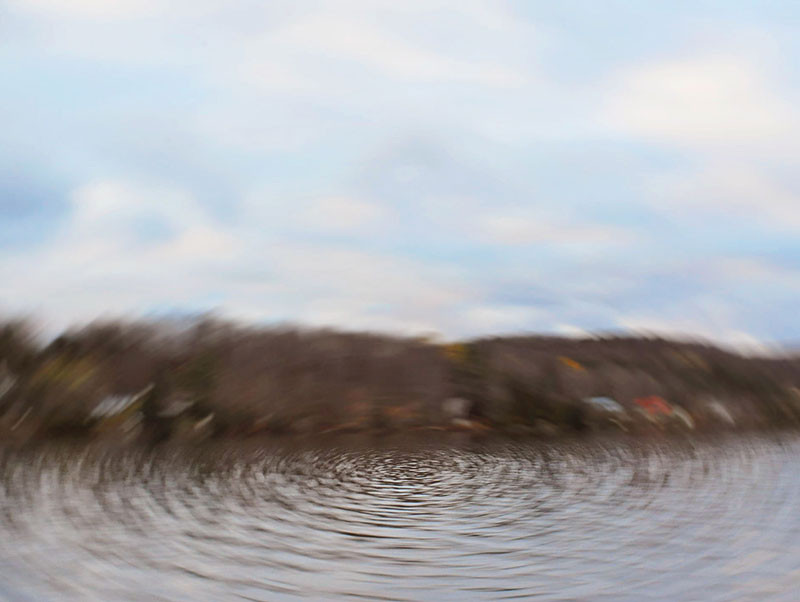Roberto Pellegrinuzzi - Résonances
29 Aug - 17 Oct 2015
For several years now, my visual art has been focused in part on photography, its modes of representation, history and characteristics, and its mechanics and physical properties.
Curated by Joan Foncuberta, the theme of Le mois de la photo 2015 is the “post photographic condition.” I was invited to submit a proposal that addressed the proliferation of images. The objective of the project, Mémoires, is monumental sculpture composed of 275,000 photographs representing daily life, both to illustrate and underscore this excessive proliferation. The installation consists of approximately 6,000 chains holding roughly 50 small photos each, organized in the space so as to create a cloud. The number of photos reflects the estimated life span, or planned obsolescence of a digital sensor, which is approximately 275,000 photos. The idea is to fill this space with the mass of information produced by a single digital camera throughout its projected lifetime and transform its output into a sort of monument. The installation resembles a cloud but also a brain. Time and memory surface as we penetrate to the centre of this mass of photographs floating in space. Becoming an extension of our brain, the sculpture exposes the confusion we experience faced by a surfeit of information. The disposition also references cloud-based information systems that are now a part of our lives and epitomize the excessiveness of information that circulates.
Drawing on the same inspiration, the exhibition Résonances echoes Mémoires (an assembly of 275,000 snapshots that intends to reconstruct the digital cloud in a metaphoric, albeit real and tangible, way). This project, developed over a period of 16 months, required taking an average of 4,300 shots a week - approximately 600 daily. Clearly, at this rate, not every photo is carefully framed, the act of taking a photo becomes an automatic reflex, perhaps ...
We can assume that 85% of all shots are taken in quick succession, the only concern being to capture the present moment, a concept that is itself obviously debatable. Throughout this project the camera was in “aperture priority” mode without autofocus (already a departure from the settings used for taking all those falsely beautiful photos/images found in the digital cloud). The result: numerous meaningless shots and moments from daily life. From this repetitive and fairly slapdash process—a process that required taking 600 photos each day, which is already obsessive—and given the lack of care taken to set up the shots, startling images emerge.
In this series, each of the thousands of photos from Mémoires were reviewed, and some extracted and recuperated here like trophies taken in a mad hunt. These low-resolution photos, blown up as much as possible, become a bit fuzzy, just like our memories that produce more or less precise recollections. Reworked and magnified, these images represent dubious memories, sometimes idyllic visions, of a distant present.
- Roberto Pellegrinuzzi
Curated by Joan Foncuberta, the theme of Le mois de la photo 2015 is the “post photographic condition.” I was invited to submit a proposal that addressed the proliferation of images. The objective of the project, Mémoires, is monumental sculpture composed of 275,000 photographs representing daily life, both to illustrate and underscore this excessive proliferation. The installation consists of approximately 6,000 chains holding roughly 50 small photos each, organized in the space so as to create a cloud. The number of photos reflects the estimated life span, or planned obsolescence of a digital sensor, which is approximately 275,000 photos. The idea is to fill this space with the mass of information produced by a single digital camera throughout its projected lifetime and transform its output into a sort of monument. The installation resembles a cloud but also a brain. Time and memory surface as we penetrate to the centre of this mass of photographs floating in space. Becoming an extension of our brain, the sculpture exposes the confusion we experience faced by a surfeit of information. The disposition also references cloud-based information systems that are now a part of our lives and epitomize the excessiveness of information that circulates.
Drawing on the same inspiration, the exhibition Résonances echoes Mémoires (an assembly of 275,000 snapshots that intends to reconstruct the digital cloud in a metaphoric, albeit real and tangible, way). This project, developed over a period of 16 months, required taking an average of 4,300 shots a week - approximately 600 daily. Clearly, at this rate, not every photo is carefully framed, the act of taking a photo becomes an automatic reflex, perhaps ...
We can assume that 85% of all shots are taken in quick succession, the only concern being to capture the present moment, a concept that is itself obviously debatable. Throughout this project the camera was in “aperture priority” mode without autofocus (already a departure from the settings used for taking all those falsely beautiful photos/images found in the digital cloud). The result: numerous meaningless shots and moments from daily life. From this repetitive and fairly slapdash process—a process that required taking 600 photos each day, which is already obsessive—and given the lack of care taken to set up the shots, startling images emerge.
In this series, each of the thousands of photos from Mémoires were reviewed, and some extracted and recuperated here like trophies taken in a mad hunt. These low-resolution photos, blown up as much as possible, become a bit fuzzy, just like our memories that produce more or less precise recollections. Reworked and magnified, these images represent dubious memories, sometimes idyllic visions, of a distant present.
- Roberto Pellegrinuzzi

